Last updated: 2025-11-10
Changes to orders in Opter Driver
In this article
By default, the driver can make changes to the shipments in Opter Driver by selecting Changes from the menu. This can be useful if, for example, the number of packages or the driving time is not correct. You can set up so that drivers cannot change the shipments in the app by setting the Mobile data settings ChangesPermission to "False".
Making changes to the shipments in the different variants of Opter Driver:
-
In Opter Driver for iOS and Opter Driver Labs for Android, the driver selects Changes from the menu (
 ) in the detail view (see image below) or presses Changes in the POD view.
) in the detail view (see image below) or presses Changes in the POD view.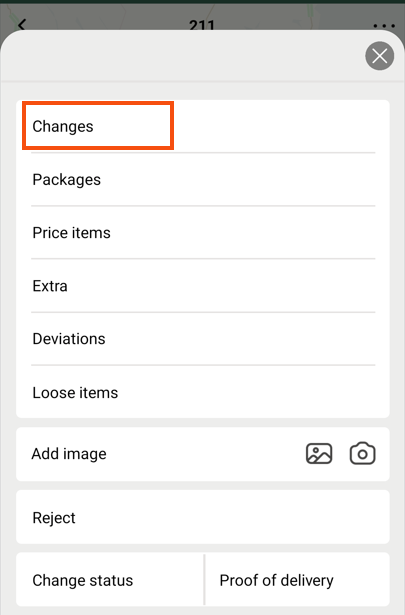
-
In Opter Driver for Android (classic), the driver selects Changes from the menu (
 ) in the detail view.
) in the detail view.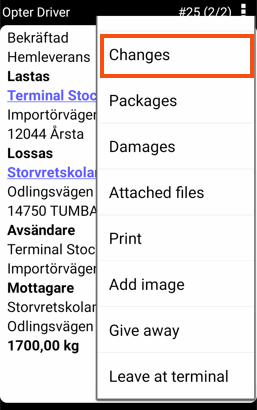
Defining whether or not drivers are allowed to make changes to shipments
-
In Opter, click on Settings > Mobile data > Settings mobile data.
-
Click on an empty row in the Name column and then on the down arrow in the row being added.
-
Select ChangesPermission from the list.
-
Enter “true” or “false” in the Value column as follows:
-
”True” (default): Drivers are allowed to make changes to the shipments in the app. the Changes menu option is displayed in the app. In Opter Driver for iOS and Opter Driver Labs for Android, the Changes button is also shown in the POD view.
-
“False”: Drivers are not allowed to make changes to the shipments in the app. the Changes menu option is not displayed. The Changes button is not displayed in the POD view.
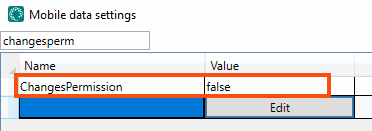
-
-
Click on Save.
By default, changes made in Opter Driver must be manually approved in dispatch for the change to be saved, but it can be set so that no changes at all need to be approved, or only certain changes need to be approved.
For more information, see Setting how changes made in Opter Driver are approved
If Changes has been set to be displayed (“true” or no value for ChangesPermission), it is also possible to choose where on the menu the option is displayed. For example, if Changes should be at the top of the menu, immediately after the next status, select ChangesOrder in the Name column of the mobile data settings and enter “1” in the Value column. The lower the number, the higher up the menu it is.
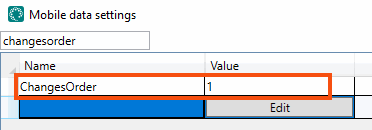
-
The next status of the shipment (e.g. Picked up or Delivered) will always be at the top of the menu.
-
The default setting for all options on the menu is “99”. This means that it is not sufficient to set one of them to “2” for that menu option to appear second on the menu. If “1” is not entered for any other option, the menu option with the value “2” will be placed at the top. The menu option with the lowest number appears at the top of the menu.
Users who are logged in to the app when the changes are saved in Opter must log out and then log back in to the app to see the changes.
Customise the view Changes
When the drivers click on Changes, the Changes view opens:
-
In Opter Driver for iOS and Opter Driver Labs for Android.

-
In Opter Driver (classic) for Android.

It is possible to choose which fields to display and the order in which they are displayed, and also to rename them. The view is managed with the settings starting with “SHI_” in the mobile data settings. There are three types of SHI_settings:
-
"SHI_XyzPermission", for example SHI_DistanceKMPermission: Controls whether or not the field is displayed in the view.
-
”SHI_XyzName”, for example SHI_DistanceKMName: the default name for the field can be replaced by a custom name.
-
"SHI_XyzOrder", for example SHI_DistanceKMOrder: where in the view the field should be displayed. The lower the number, the higher up the view it is.
If no settings are configured for any of the mobile data settings starting with “SHI_”:
-
In Opter Driver for iOS and Opter Driver Labs for Android, all the fields except the (SHI_DriverMessagePermission), Order date (SHI_OrderDatePermission) and Sender instructions (SHI_SenderInstructionPermission) fields are displayed by default,.
-
In Opter Driver (classic) for Android, all fields are displayed by default.
The fields displayed by default are shown with their default names.
For more information about the fields and their settings, see Mobile data settings (window). Some of the settings also affect the New order view, for example SHI_PackagesName and SHI_PackagesOrder.
For Opter Driver for iOS and Opter Driver Labs for Android version 2.4.27 and later, the settings for extra dimension names and extra IDs also affect the mission list and detail view. For more information, see Extra dimension and extra ID in Opter Driver.
For Opter Driver (classic) for Android, the following applies:
-
All SHI_XyzPermission settings are “true” by default, which means that all fields will be displayed if no settings at all are configured.
-
If an SHI_XyzPermission setting is set to “true”, the SHI_XyzPermission settings for all the other fields to be displayed must be set to “true”, otherwise only the fields given the “true” value will be displayed.
-
If an SHI_XyzPermission setting is set to “false”, the SHI_XyzPermission settings for all the fields to be displayed must be set to “true”, otherwise no fields at all will be displayed.
The following applies for Opter Driver for iOS and Opter Driver Labs for Android:
-
All SHI_XyzPermission settings are “true” by default, except for the SHI_DriverMessagePermission (), SHI_OrderDatePermission (Order date) and SHI_SenderInstructionPermission (Sender instructions) settings. This means that all fields except for , Order date and Sender instructions will be displayed if no settings whatsoever are configured.
To set which fields should be displayed, proceed as follows:
-
Click on Settings > Mobile data > Settings mobile data.
-
Click on an empty row in the Name column and then on the down arrow in the row being added. Select the SHI_XyzPermission setting for the field to be displayed/hidden, for example SHI_DistanceKMPermission (which controls whether the Distance/Distance (km) field is displayed or not). For more information on which settings correspond to which fields, see Mobile data settings (window).
-
Enter one of the following in the Value column:
-
“True”: if the field should be displayed.
-
“False”: if the field should not be displayed.
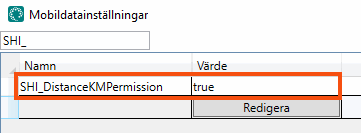
-
-
Repeat steps 2 and 3 to configure the settings for more fields.
-
Click on Save. When you have finished configuring the settings, you can close the window.
To change the default names of the fields to your own names, proceed as follows:
-
Click on Settings > Mobile data > Settings mobile data.
-
Click on an empty row in the Name column and then on the down arrow in the row being added. Select the SHI_XyzName setting for the field to be renamed, for example SHI_DistanceKMName (which is the Distance/Distance (km) field). For more information on which settings correspond to which fields, see Mobile data settings (window).
-
Enter the new name of the field in the Value column, for example “Distance driven in km”.

-
Repeat steps 2 and 3 for all fields to be renamed.
-
Click on Save. When you have finished configuring the settings, you can close the window.
For Opter Driver for iOS and Opter Driver Labs for Android version 2.4.27 and later, the settings for extra dimension names and extra IDs also affect the mission list and detail view. For more information, see Extra dimension and extra ID in Opter Driver.
To specify the order in which the fields are displayed, proceed as follows:
-
Click on Settings > Mobile data > Settings mobile data.
-
Click on an empty row in the Name column and then on the down arrow in the row being added. Select the SHI_XyzOrder setting for the field to be moved up or down in the view, for example SHI_DistanceKMOrder. For more information on which settings correspond to which fields, see Mobile data settings (window).
-
In the Value column, enter a number to indicate where in the view the field should be located. The lower the number, the higher up it is. If “1” is entered, the field will be at the top of the list.
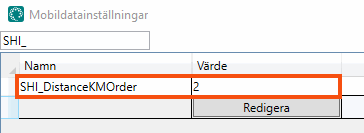
The default setting for all fields is “99”. This means that it is not sufficient to set one of them to “2” for that field to appear second in the view. If “1” is not entered for any other option, the field with the value “2” will be placed at the top. The field with the lowest number appears at the top of the view.
-
Repeat steps 2 and 3 for all fields to be moved.
-
Click on Save. When you have finished configuring the settings, you can close the window.
Users who are logged in to the app when the changes are saved in Opter must log out and then log back in to the app to see the changes.